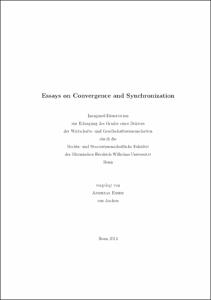Essays on Convergence and Synchronization

Essays on Convergence and Synchronization

| dc.contributor.advisor | Breitung, Jörg | |
| dc.contributor.author | Esser, Andreas | |
| dc.date.accessioned | 2020-04-19T14:32:48Z | |
| dc.date.available | 2020-04-19T14:32:48Z | |
| dc.date.issued | 08.01.2014 | |
| dc.identifier.uri | https://hdl.handle.net/20.500.11811/5950 | |
| dc.description.abstract | Convergence of macroeconomic aggregates and subsequent synchronization of the cyclical features affecting these aggregates have been at the heart of economic debate for quite a while. Especially with the recent developments concerning the creation and crisis of a European common currency area, the question whether counties are similar enough to be targeted by uniform policy rules has been a crucial one. Beyond this relevance to an economist, the phenomena are also interesting from an econometric perspective. This thesis contains three self-contained chapters that contribute to the understanding of convergence and synchronization in various ways. Chapter 1 evaluates a novel approach to capture economic convergence as a process of transition. It considers the framework from Phillips and Sul (2007) that explicitly allows for periods of transitional divergence by separating a common component from idiosyncratic fluctuations and investigates its performance in a classical setting of time series convergence, considering both asymptotic results and Monte Carlo simulation methods. It turns out that in a setting where the time dimension considerably exceeds the cross-sectional dimension, the performance of the regression test is inferior to that of the standard cointegration tests. Chapter 2 considers a different way of incorporating transitory periods into convergence analysis. It argues that convergence is a dynamic process that can better be captured by considering changes in persistence. Tests for changes in persistence are applied for interest rate differentials on long-term government bonds for a broad set of countries. Overwhelming evidence for convergence in interest rates can be found when considering countries now using the Euro, while very little evidence can be found for previously stable relationships beginning to diverge. Chapter 3 puts the focus on comovement between output series and considers various concepts based in either the time or the frequency domain to detect and describe cyclical comovements in output data. The use of multivariate wavelet analysis and a modification of the cohesion statistic from Fourier analysis is suggested to simultaneously assess comovement at the frequency level and over time. The main finding is that synchronization does indeed vary with cycle length and that it has been affected by events during the time span of the sample. | |
| dc.language.iso | eng | |
| dc.rights | In Copyright | |
| dc.rights.uri | http://rightsstatements.org/vocab/InC/1.0/ | |
| dc.subject | Konvergenz | |
| dc.subject | Zeitreihenanalyse | |
| dc.subject | EWU | |
| dc.subject | Wavelets | |
| dc.subject | Persistenzänderung | |
| dc.subject | economic convergence | |
| dc.subject | time series analysis | |
| dc.subject | EMU | |
| dc.subject | changing persistence | |
| dc.subject.ddc | 330 Wirtschaft | |
| dc.title | Essays on Convergence and Synchronization | |
| dc.type | Dissertation oder Habilitation | |
| dc.publisher.name | Universitäts- und Landesbibliothek Bonn | |
| dc.publisher.location | Bonn | |
| dc.rights.accessRights | openAccess | |
| dc.identifier.urn | https://nbn-resolving.org/urn:nbn:de:hbz:5-34652 | |
| ulbbn.pubtype | Erstveröffentlichung | |
| ulbbnediss.affiliation.name | Rheinische Friedrich-Wilhelms-Universität Bonn | |
| ulbbnediss.affiliation.location | Bonn | |
| ulbbnediss.thesis.level | Dissertation | |
| ulbbnediss.dissID | 3465 | |
| ulbbnediss.date.accepted | 19.12.2013 | |
| ulbbnediss.fakultaet | Rechts- und Staatswissenschaftliche Fakultät | |
| dc.contributor.coReferee | Demetrescu, Matei |
Files in this item
This item appears in the following Collection(s)
-
E-Dissertationen (261)




